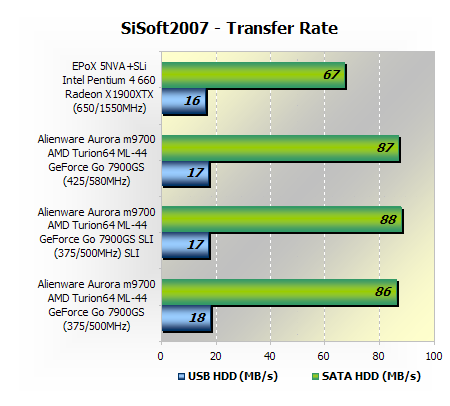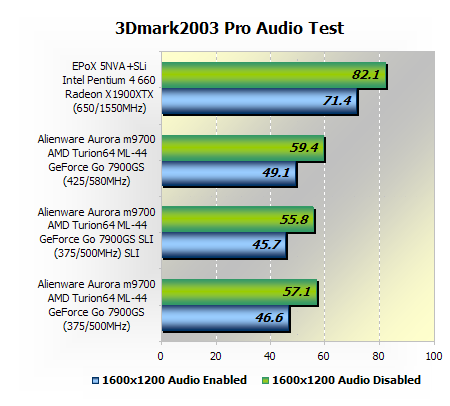System Specs & Subsystem Benchmarks
|
Alienware Aurora m9700 Specifications AMD Turion64 ML-44 (2.40GHz) PC3200 DDR400 1GB Memory (2x) Seagate 100GB 7200RPM (Serial ATA) RAID0 (2x) GeForce Go 7900GS (256MB) SLI 8x Dual Layer DVD±RW Integrated Gigabit Ethernet RJ-45 Integrated 56K V.92 modem RJ-11 Realtek 802.11b/g Wireless 17" Wide Screen WUXGA 1920 x 1200 Intel High-Definition audio Internal stereo speakers w/subwoofer 4 Hi-speed USB 2.0 ports Express Card Slot /54mm 4-in-1 Memory Card Reader Height: 1.85" Width: 15.65" Depth: 11.75" More here Software Microsoft Windows XP Pro (SP2) NVIDIA Forceware 91.31 NVIDIA nForce4 AMD 6.70 |
Desktop System Specifications Intel Pentium 4 660 (3.60GHz) Corsair PC5400 Pro 2GB DDR2 EPoX 5NVA+SLi (nForce4 SLI) Seagate 250GB 7200RPM (Serial ATA II) ASUS Radeon X1900XTX (512MB) Software Microsoft Windows XP Pro (SP2) ATI Catalyst 6.6 NVIDIA nForce4 Intel 8.22 |
Note: Throughout the benchmark tests the benchmarked configurations are the following:
(1) Pentium D desktop configuration above,
(2) the Aurora m9700 configured as it came from factory with SLI enabled,
(3) Aurora m9700 with SLI disabled/single videocard, and
(4) Aurora m9700 with SLI disabled/single videocard overclocked.


The SiSoft2007 SATA hard drive performance strongly favored the Aurora m9700 RAID0 setup over our desktop test system which was included for comparison purposes. The notebook was up to 30% faster when it came to hard drive read/write performance, according to SiSoft2007. The USB 2.0 performance was also quite good, as the Aurora m9700 matched the desktop test system.
Enabling the Aurora m9700's audio controller saw a 20% loss in frame rates, which was about 7% higher than that of the test system. The Pentium 4 660 test system using the ultra quick Radeon X1900XTX was quite a lot faster than the Aurora m9700. It is also very interesting to note what the SLI-enabled configuration was actually the slowest. Keep this in mind as there are many more 3D benchmarks to follow.